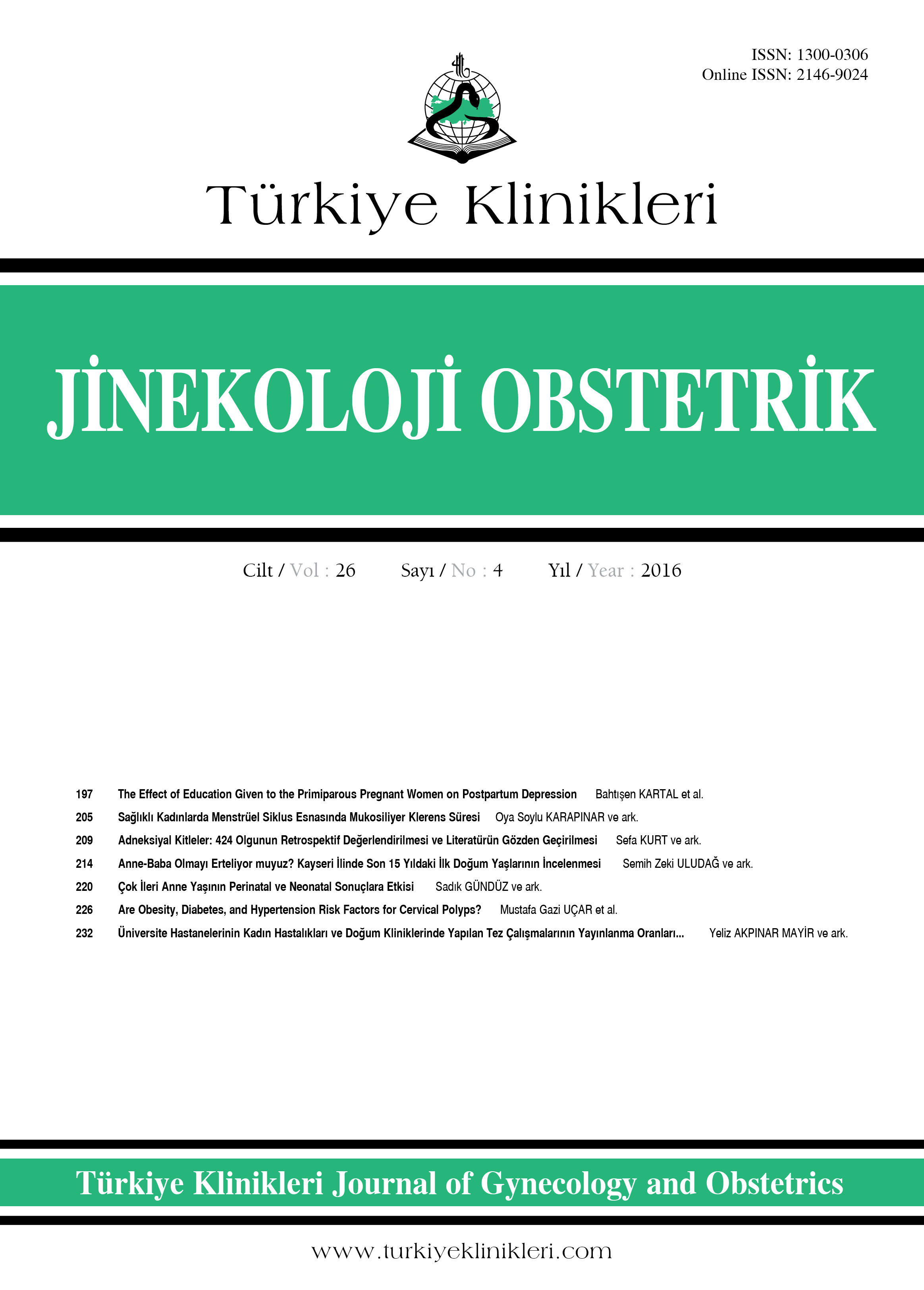Open Access
Peer Reviewed
ORIGINAL RESEARCH
2809 Viewed1541 Downloaded
Are Obesity, Diabetes, and Hypertension Risk Factors for Cervical Polyps?
Diyabet, Hipertansiyon ve Obezite Servikal Polipler İçin Risk Faktörü müdür?
Turkiye Klinikleri J Gynecol Obst. 2016;26(4):226-31
DOI: 10.5336/gynobstet.2016-53584
Article Language: EN
Article Language: EN
Copyright Ⓒ 2025 by Türkiye Klinikleri. This is an open access article under the CC BY-NC-ND license (http://creativecommons.org/licenses/by-nc-nd/4.0/)
ABSTRACT
Objective: To investigate whether diabetes, hypertension, and obesity can be considered risk factors for cervical polyps. Material and Methods: The hospital-based case-control study was carried out. We retrospectively reviewed the records of 307 consecutive patients with cervical polyps. A control group consisting of 3 women per case-matched by the same age, same parity, same menopausal status and the same presenting symptoms. These groups were compared with respect of diabetes, hypertension and obesity prevalence. Results: The study included a total of 212 patients eligible for analysis in cervical polyp group, and a matched control group consisting of 636 women without cervical polyp. Women with cervical polyp had higher body mass index than the controls, but the difference was not statistically significant (p=0.72). The prevalence of obesity was significantly higher in the cervical polyp group than the controls (p=0.016). A statistically significant correlation was found between obesity and cervical polyps (OR: 1.351, CI: 1.062-1,718). There was no significant difference between the groups with respect to the prevalence of diabetes (p=0.795) and hypertension (p=0.703). Conclusion: Obesity appears to be a risk factor for cervical polyps. Obese women should receive special attention for potential coexistence of cervical polyps as part of their gynecological evaluation. This study supports the importance of weight management for the preventive plan of cervical polyps.
Objective: To investigate whether diabetes, hypertension, and obesity can be considered risk factors for cervical polyps. Material and Methods: The hospital-based case-control study was carried out. We retrospectively reviewed the records of 307 consecutive patients with cervical polyps. A control group consisting of 3 women per case-matched by the same age, same parity, same menopausal status and the same presenting symptoms. These groups were compared with respect of diabetes, hypertension and obesity prevalence. Results: The study included a total of 212 patients eligible for analysis in cervical polyp group, and a matched control group consisting of 636 women without cervical polyp. Women with cervical polyp had higher body mass index than the controls, but the difference was not statistically significant (p=0.72). The prevalence of obesity was significantly higher in the cervical polyp group than the controls (p=0.016). A statistically significant correlation was found between obesity and cervical polyps (OR: 1.351, CI: 1.062-1,718). There was no significant difference between the groups with respect to the prevalence of diabetes (p=0.795) and hypertension (p=0.703). Conclusion: Obesity appears to be a risk factor for cervical polyps. Obese women should receive special attention for potential coexistence of cervical polyps as part of their gynecological evaluation. This study supports the importance of weight management for the preventive plan of cervical polyps.
ÖZET
Amaç: Diyabet, hipertansiyon ve obezitenin servikal polipler için risk faktörü olup olmadığını araştırmaktır. Gereç ve Yöntemler: Hastane tabanlı vaka-kontrol çalışması oluşturuldu. 307 ardışık servikal polip hastasının kayıtları retrospektif olarak değerlendirildi. Her servikal polip hastası için, aynı yaş, aynı parite, aynı menopozal durumda ve aynı başvuru şikayeti ile gelen 3 kontrol hastası belirlendi. Gruplar hipertansiyon, diyabet ve obezite prevalansı açısından karşılaştırıldı. Bulgular: Çalışma kriterlerine uygun servikal polibi olan 212 hasta vaka grubuna ve servikal polibi olmayan eşleştirilmiş 636 hasta kontrol grubuna dahil edildi. Servikal polip hastalarının beden kitle indeksi, kontrol grubundan daha fazlaydı, ancak bu fark istatistiksel anlamlı değildi (p=0,72). Obezite prevalansı servikal polip grubunda, kontrol grubundan istatistiksel olarak anlamlı düzeyde yüksek bulundu (p=0,016). Obezite ve servikal polipler arasında istatistiksel anlamlı düzeyde korelasyon saptandı (OR: 1,351, GA: 1,062-1,718). iki grup arasında hipertansiyon (p=0,703) ve diyabet (p=0,795) prevalansı değerlendirildiğinde istatistiksel olarak anlamlı fark tespit edilmedi. Sonuç: Obezite servikal polipler için risk faktörü olarak görünmektedir. Obez hastalara muhtemel servikal polip birlikteliği nedeniyle jinekolojik muayene sırasında özellikle dikkat edilmelidir. Çalışma servikal poliplerin koruyucu tedavisinde kilo kontrolünün önemini desteklemektedir.
Amaç: Diyabet, hipertansiyon ve obezitenin servikal polipler için risk faktörü olup olmadığını araştırmaktır. Gereç ve Yöntemler: Hastane tabanlı vaka-kontrol çalışması oluşturuldu. 307 ardışık servikal polip hastasının kayıtları retrospektif olarak değerlendirildi. Her servikal polip hastası için, aynı yaş, aynı parite, aynı menopozal durumda ve aynı başvuru şikayeti ile gelen 3 kontrol hastası belirlendi. Gruplar hipertansiyon, diyabet ve obezite prevalansı açısından karşılaştırıldı. Bulgular: Çalışma kriterlerine uygun servikal polibi olan 212 hasta vaka grubuna ve servikal polibi olmayan eşleştirilmiş 636 hasta kontrol grubuna dahil edildi. Servikal polip hastalarının beden kitle indeksi, kontrol grubundan daha fazlaydı, ancak bu fark istatistiksel anlamlı değildi (p=0,72). Obezite prevalansı servikal polip grubunda, kontrol grubundan istatistiksel olarak anlamlı düzeyde yüksek bulundu (p=0,016). Obezite ve servikal polipler arasında istatistiksel anlamlı düzeyde korelasyon saptandı (OR: 1,351, GA: 1,062-1,718). iki grup arasında hipertansiyon (p=0,703) ve diyabet (p=0,795) prevalansı değerlendirildiğinde istatistiksel olarak anlamlı fark tespit edilmedi. Sonuç: Obezite servikal polipler için risk faktörü olarak görünmektedir. Obez hastalara muhtemel servikal polip birlikteliği nedeniyle jinekolojik muayene sırasında özellikle dikkat edilmelidir. Çalışma servikal poliplerin koruyucu tedavisinde kilo kontrolünün önemini desteklemektedir.
MENU
POPULAR ARTICLES
MOST DOWNLOADED ARTICLES





This journal is licensed under a Creative Commons Attribution-NonCommercial-NoDerivatives 4.0 International License.










